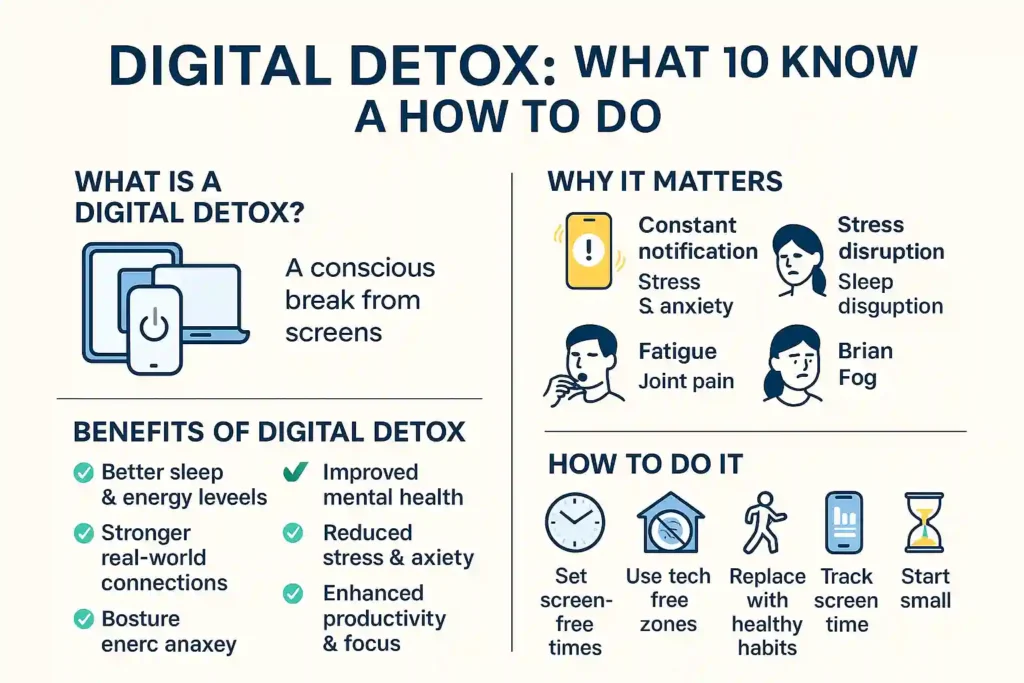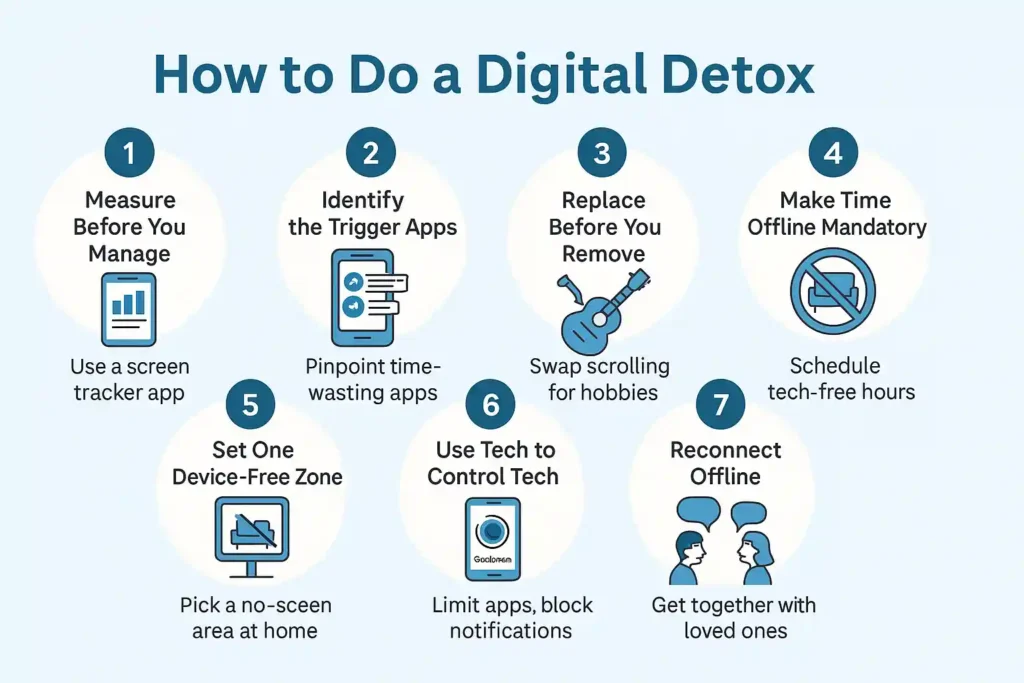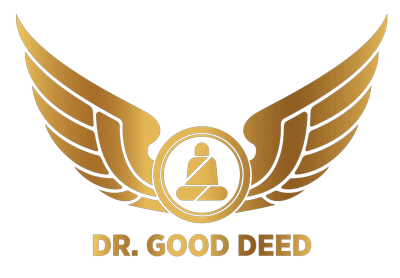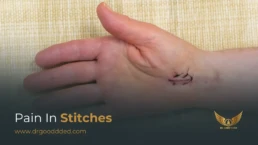Key Takeaways
- A digital detox helps reduce stress and improve focus by stepping away from screens.
- It supports mental health and technology balance, especially for those dealing with anxiety or burnout.
- Even small steps like one hour of tech-free time daily can make a big impact.
- It’s not about quitting devices forever, but using them smarter.
- A well-planned digital detox challenge can reset your mood, energy, and sleep patterns fast.
What Is a Digital Detox?

Table of Contents
ToggleA digital detox is a conscious decision to take a break from digital devices like smartphones, laptops, TVs, and tablets. It’s about resetting your brain and body from technology overload caused by too much screen use.
During a digital detoxification, you limit exposure to apps, emails, notifications, and social media. This helps reduce phone addiction, improve real-world awareness, and bring your mind back into the present moment.
Many people experience digital burnout without realizing it. That tired, drained feeling after scrolling for hours? That’s your body telling you it’s time to stop.
When you do proper digital detoxing, you break that cycle. You regain control over your screen habits. It’s like giving your brain a fresh start and you’ll feel the difference fast.
Why Do You Need a Digital Detox?
Think about your day. How many hours do you spend on screens?
Too much screen use can cause:
- Eye pain
- Headaches
- Trouble sleeping
- Stress
- Lack of focus
This is called information overload. Your brain gets so much data that it doesn’t know what to do with it. Over time, it makes you feel tired, anxious, and dull.
A digital detoxing period helps you slow down. It cuts the pressure of always checking messages, emails, or likes. It gives your brain time to breathe.
Also, many people forget how real life feels. With a social media break, you get back to things that matter such as people, nature, hobbies, and rest.
Unplugging from devices is a need. And the longer you delay, the more your mind stays tired and distracted.
The Benefits of a Digital Detox
You don’t have to quit technology completely. But doing a digital detox gives several clear benefits. Let’s look at the main digital detox benefits:
- Better Sleep: Blue light from screens hurts your sleep. Even one hour of tech-free time before bed can help your brain relax.
- Improved Mood: Less time on social media means fewer chances to compare yourself to others. This helps reduce sadness and fear.
- Sharper Focus: With fewer pings and notifications, your mind learns to focus again. This helps in work, school, and real-life talks.
- Less Stress: Taking a break from screen drama cuts your stress. No endless news or online fights. Just peace.
- More Real-Life Joy: You start enjoying nature, books, talks, and silence again. You feel connected, not to Wi-Fi, but to life.
These digital detox benefits come fast. Many people feel better after one day. Imagine what a whole week can do.
Also, for those struggling with mental health and technology, this break can be the first step toward healing.
How to Do Digital Detox?

Doing a digital detox doesn’t mean throwing your phone away. It just means using screens less and living more.
Here’s how to start your own digital detox challenge:
1. Measure Before You Manage
Use a screen tracker app (like Digital Wellbeing or Screen Time) for 3 days. Get a baseline of how much time you actually spend. Awareness is step one in any solid digital detoxification.
2. Identify the Trigger Apps
Don’t delete everything. Pinpoint apps that suck your time with little return. For most, it’s social media, short videos, or endless news scrolls. These are your detox targets.
3. Replace Before You Remove
Your brain hates empty time. Instead of just quitting, replace the habit. Reading, cooking, walking, doodling, anything that doesn’t require a screen fills the gap. This reduces information overload without triggering withdrawal.
4. Make Time Offline Mandatory
Designate 2-3 hours daily as tech-free time, no exceptions. Early morning or right before bed works best. You’ll feel your brain breathe. Try journaling or real-life chats during this time.
5. Set One Device-Free Zone
Pick a place in your home, kitchen, bedroom, or balcony, where devices are not allowed. This helps with sleep and screen time, improves conversation, and makes disconnection feel normal.
6. Use Tech to Control Tech
Ironically, tech can help with digital detoxing. Use tools that block addictive apps, pause notifications, or dim your screen after a set time. This builds long-term discipline.
7. Reconnect Offline
Plan activities with real people. A coffee date, board game night, or just talking to a neighbor. These bring back the joy of reconnecting offline, something screens can never replace.
By doing all this, you’re not just reducing screen use. You’re improving your digital wellbeing, reclaiming your time, and resetting your brain for what really matters.
Conclusion
You don’t have to delete all your apps or live in a cave.
But you do need a break.
A digital detox is not about being anti-technology. It’s about being pro-you. Your mind, eyes, sleep, and mood need rest.
Start small. Stay real. Take back control from the apps, screens, and endless scroll. Rebuild your balance. Find joy in unplugging from devices, even for a while.
The truth is, we don’t need to be online all the time to matter. Sometimes, the best updates come when you log off.
Digital Detox FAQs
What is a digital detox?
A digital detox is a break from screens to reset your brain, reduce stress, and reconnect with real life through offline experiences and better habits.
How to do a digital detox?
Track screen time, remove trigger apps, add tech-free time, and commit to regular digital detox challenges for improved clarity, focus, and balance.
How long should I digital detox for?
Start with one hour a day. Gradually increase to a full weekend monthly. Some people benefit from longer breaks based on their phone addiction levels.
Do digital detoxes actually work?
Yes. A well-planned digital detoxing improves sleep, lowers anxiety, boosts productivity, and restores attention span quickly, often within a day or two.
What are the 5 benefits of a digital detox?
Better sleep, reduced stress, sharper focus, stronger real-world connections, and improved mood, these are proven, lasting digital detox benefits.

This article is medically reviewed by Dr. Chandril Chugh, Board-Certified Neurologist, providing expert insights and reliable health information.
Dr. Chandril Chugh is a U.S.-trained neurologist with over a decade of experience. Known for his compassionate care, he specializes in treating neurological conditions such as migraines, epilepsy, and Parkinson’s disease. Dr. Chugh is highly regarded for his patient-centered approach and dedication to providing personalized care.








